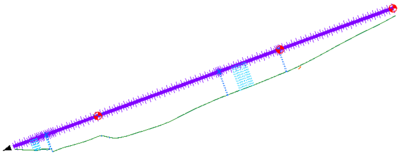SMS:GenCade
The GenCade model is a next generation combination of previous long-term planform evolution of a beach models GENESIS (GENEralized Model for SImulating Shoreline Change[1]) and Cascade[2].
GenCade is a regional model for calculating coastal sediment transport, morphology change, and sand bypassing at inlets and engineered structures. GenCade is developed by the U.S. Army Engineer Research and Development Center (USACE-ERDC), Coastal and Hydraulics Laboratory (CHL). The developers maintain documentation for the model, comments on the interface and steps for a sample application.
The GenCade model can be added to a paid edition of SMS.
GenCade Coverage
The GenCade coverage allows defining the geographical location of the characteristics and structures of a GenCade simulation. One or more coverages can be mapped to the simulation.
Functionality
GenCade simulates shoreline change relative to regional morphologic constraints upon which these processes take place. The evolution of multiple interacting coastal projects and morphologic features and pathways, such as those associated with inlets and adjacent beaches may also be simulated. The model supports responses to imposed wave conditions, coastal structures, and other engineering activity (e.g., beach nourishment).
Typical longshore extents and time periods of modeled projects can be in the ranges of one to 100 km and one month to multiple decades, respectively, and almost arbitrary numbers and combinations of groins, detached breakwaters, seawalls, jetties, and beach fills can be represented. GenCade simulates shoreline change produced by spatial and temporal differences in longshore sand transport. Shoreline movement such as that produced by beach fills and river sediment discharges can also be represented. The main utility of the modeling system lies in simulating the response of the shoreline to structures sited in the nearshore. Shoreline change produced by cross-shore sediment transport as associated with storms and seasonal variations in wave climate cannot be simulated; support of cross-shore processes are being considered for future versions of the model.
Capabilities of GenCade:
- Almost arbitrary numbers and combinations for groins, jetties, detached breakwaters, beach fills, and seawalls
- Compound structures such as T-shaped, Y-shaped, and spur groins
- Bypassing of sand around and transmission through groins and jetties
- Diffraction at detached breakwaters, jetties, and groins
- Coverage of wide spatial extent
- Offshore input waves of arbitrary height, period, and direction
- Multiple wave trains (as from independent wave generation sources)
- Sand transport due to oblique wave incidence and longshore gradient in height
- Wave transmission at detached breakwaters
Practical Notes For Using GenCade
Shoreline change models are not applicable to simulating a randomly fluctuating beach system in which no trend in shoreline position is evident. In particular, GenCade is not applicable to calculating shoreline change in the following situations that involve beach change unrelated to coastal structures, boundary conditions, or spatial differences in wave-induced longshore sand transport:
- Beach change inside inlets or in areas dominated by tidal flow
- Beach change produced by wave-generated currents
- Storm-induced beach erosion in which cross-shore sediment transport processes are dominant
- Scour at structures
Limitations of GenCade:
- No wave reflection from structures
- No direct provision for changing tide level
- Basic limitations of shoreline change modeling theory
Case Studies / Sample Problems
- Tutorials for learning to use GenCade in SMS are under development.
Related Topics
External Links
- US Army Corps of Engineers Coastal & Hydraulics Laboratory GENESIS website [3]
- GENESIS, Report 1, Technical Reference [4]
- User's Guide to the Shoreline Modeling System [5]
- Mar 2002 ERDC/CHL CHETN-II-45 Wave Transmission at Detached Breakwaters for Shoreline Response Modeling [6]
- Cascade User Guide: [7]
- Cascade Theory and Model Formulation: [8]
- Inlet Reservoir Model (sub-model within Cascade) [9]
SMS – Surface-water Modeling System | ||
|---|---|---|
| Modules: | 1D Grid • Cartesian Grid • Curvilinear Grid • GIS • Map • Mesh • Particle • Quadtree • Raster • Scatter • UGrid |  |
| General Models: | 3D Structure • FVCOM • Generic • PTM | |
| Coastal Models: | ADCIRC • BOUSS-2D • CGWAVE • CMS-Flow • CMS-Wave • GenCade • STWAVE • WAM | |
| Riverine/Estuarine Models: | AdH • HEC-RAS • HYDRO AS-2D • RMA2 • RMA4 • SRH-2D • TUFLOW • TUFLOW FV | |
| Aquaveo • SMS Tutorials • SMS Workflows | ||
